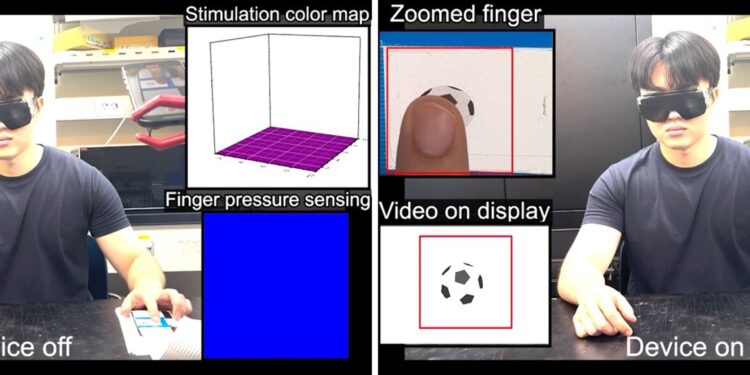Integration of TPIEA into the smartphone screen. The fabricated TPIEA was integrated into a transparent screen to provide tactile information corresponding to the video. When the TPIEA is working, pressure sensing occurs simultaneously and tactile information corresponding to the video is transmitted, allowing users to perceive the rolling of a ball through virtual electrotactile sensations implemented at their fingertips, even when blindfolded. Credit: Institute for Basic Science
A virtual haptic implementation technology that allows all users to experience the same tactile sensation has been developed. A research team led by Professor Park Jang-Ung from the Center for Nanomedicine at the Institute of Basic Science (IBS) and Professor Jung Hyun Ho from the Department of Neurosurgery at Severance Hospital has developed a technology that provides consistent tactile sensations across screens.
This research was conducted in collaboration with colleagues from Yonsei University Severance Hospital. It was published in Nature Communications August 21, 2024.
Virtual haptic implementation technology, also known as tactile rendering technology, refers to methods and systems that simulate the sense of touch in a virtual environment. This technology aims to create the sensation of physical contact with virtual objects, allowing users to feel textures, shapes, and forces as if they were interacting with real-world objects, even if the objects are digital.
This technology is increasingly being used in the fields of virtual reality (VR) and augmented reality (AR), where it is used alongside visual and auditory cues to bridge the gap between the virtual and physical worlds.
Electrotactile systems, which generate tactile sensations through electrical stimulation rather than physical vibrations, are emerging as promising next-generation tactile rendering technologies. The sensation of touch is mediated by mechanoreceptors, tactile sensory cells located in the skin that transmit tactile information to the brain in the form of electrical signals.
Electrotactile systems artificially generate these electrical signals, simulating the sense of touch. Precise and varied tactile experiences can be created by adjusting the density and frequency of the current.
Despite their potential, existing electrotactile technologies face challenges, particularly in terms of safety and consistency. Variations in skin contact pressure can lead to unstable tactile sensations, and the use of high currents raises safety concerns. To address these issues, the IBS research team developed a transparent pressure-calibrable interference electrotactile actuator (TPIEA).
Constant tactile sensation through pressure calibration. Variations in electrical tactile intensity as a function of current density are examined under pressure-compensated and non-pressure-compensated conditions. In the absence of pressure compensation, no discernible pattern emerges in the tactile sensations reported by users. Conversely, when pressure is uniformly compensated, alterations in tactile sensations are consistently manifested. It is evident that when finger pressure is high, an increased intensity of tactile sensation is perceived even at lower current levels. Credit: Nature Communications (2024). DOI: 10.1038/s41467-024-51593-2
The TPIEA consists of two main components: an electrode section responsible for generating electrotactile sensations and a pressure sensor section that adjusts to finger pressure. The researchers significantly reduced the electrode impedance by applying platinum nanoparticles to an indium tin oxide electrode.
This not only reduced the impedance compared to conventional electrodes, but also achieved a high transmittance of about 90%. The integrated pressure sensor ensures users receive consistent tactile feedback no matter how they touch the screen.
In addition, the research team performed a somatosensory evoked potential (SEP) test to quantify tactile sensations. By examining the responses of the user’s somatosensory system to variations in electrotactile stimulation current and frequency, they were able to quantitatively differentiate and normalize tactile sensations.
The team was able to implement more than nine distinct types of electrotactile sensations, ranging from hair-like to glass-like, depending on the current density and frequency of electrical stimulation. The team also demonstrated that TPIEA could be integrated into smartphone displays to reliably produce complex tactile patterns.
In addition, the research introduced the phenomenon of interference into the field of electrotactile technology. The interference phenomenon refers to the frequency and amplitude variations that occur when two electromagnetic fields overlap.
This allowed the researchers to elicit the same intensity of electrotactile sensation with a current density 30% lower than previously required and achieve an improvement of approximately 32% in tactile resolution. This research demonstrates the highest level of tactile resolution among current electrotactile technologies, including the Teslasuit.
Lead researcher Park Jang-Ung said, “With this electrotactile technology, we can effectively integrate visual information from displays with tactile information. We expect that the results of this research will greatly improve the interaction between users and devices in various augmented reality, virtual reality, and smart device applications based on interference stimulation.”
More information:
Kyeonghee Lim et al., Interferential haptic stimulation and coherent quantitative tactility in a transparent electrotactile display with pressure-sensitive transistors, Nature Communications (2024). DOI: 10.1038/s41467-024-51593-2
Provided by the Institute of Basic Sciences
Quote:Enhanced virtual haptic technology enables uniform tactile sensation across all screens (2024, September 9) retrieved September 9, 2024 from
This document is subject to copyright. Apart from any fair dealing for the purpose of private study or research, no part may be reproduced without written permission. The content is provided for informational purposes only.



